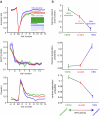Basal ganglia deep brain stimulation restores cognitive flexibility and exploration-exploitation balance disrupted by NMDA-R antagonism
- PMID: 40436862
- PMCID: PMC12119807
- DOI: 10.1038/s41467-025-60044-5
Basal ganglia deep brain stimulation restores cognitive flexibility and exploration-exploitation balance disrupted by NMDA-R antagonism
Abstract
Learning thrives on cognitive flexibility and exploration. Subjects with schizophrenia have impaired cognitive flexibility and maladaptive exploration patterns. The basal ganglia-dorsolateral prefrontal cortex (BG-DLPFC) network plays a significant role in learning processes. However, how this network maintains cognitive flexibility and exploration patterns and what alters these patterns in schizophrenia remains elusive. Using a combination of extracellular recordings, pharmacological manipulations, macro-stimulation techniques, and mathematical modeling, we show that in the nonhuman primate (NHP), the external segment of the globus pallidus (GPe, the central nucleus of the BG network) modulates cognitive flexibility and exploration patterns (experiments were done in females only). We found that chronic, low-dose administration of N-methyl-D-aspartate receptor (NMDA-R) antagonist, phencyclidine (PCP), decreases directed exploration but increases random exploration, as seen in schizophrenia. In line with adaptive working-memory reinforcement-learning models of the BG-DLPFC network, low-frequency GPe macro-stimulation restores the balance of both exploration types. Our findings suggest that exploration-exploitation imbalance reflects abnormal BG-DLPFC activity and that GPe stimulation may restore it.
© 2025. The Author(s).
Conflict of interest statement
Competing interests: The authors declare no competing interests.
Figures







References
MeSH terms
Substances
Grants and funding
LinkOut - more resources
Full Text Sources

